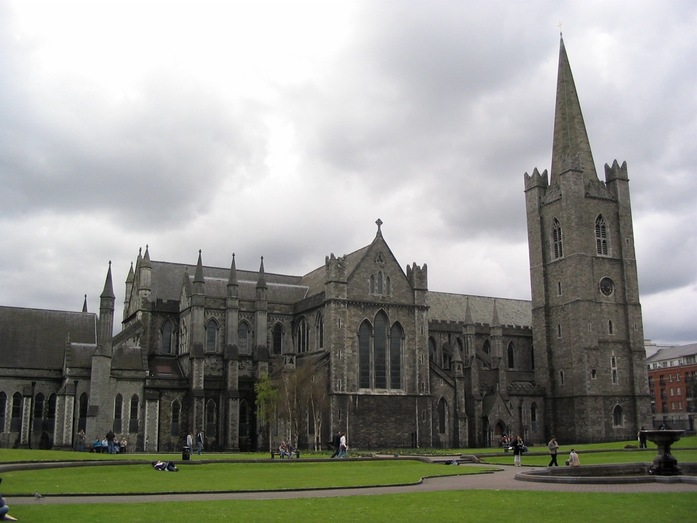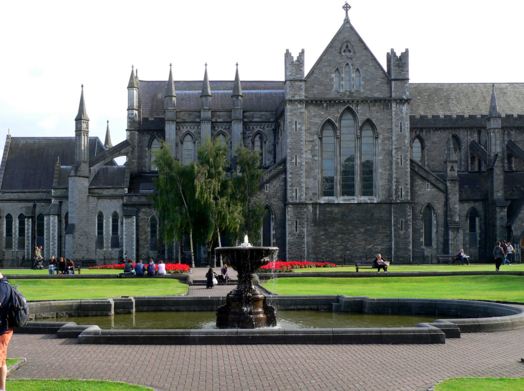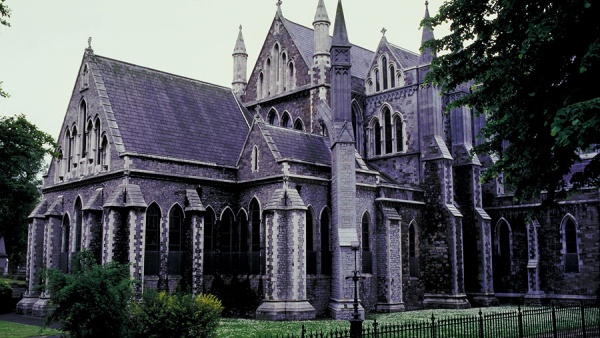Saint Patrick's Cathedral in Dublin, also known as The National Cathedral and Collegiate Church of Saint Patrick, Dublin, or in the Irish language as Ard-Eaglais Naomh Pádraig, founded in 1191, is the largest church in Ireland and one of Dublin's two Church of Ireland cathedrals. It has a 43-metre (140 feet) spire.[1] Christ Church, the other cathedral, is the diocesan cathedral of the diocese of Dublin and Glendalough.
Unusually, St Patrick's is not the seat of a bishop, as the Archbishop of Dublin has his seat in Christ Church Cathedral. Since 1870, the church has designated St Patrick's as the national cathedral for the whole of Ireland, drawing chapter members from each of the twelve dioceses of the Church of Ireland. The dean is the ordinary for the cathedral; this office has existed since 1219. The most famous office holder was Jonathan Swift.
There is almost no precedent for a two-cathedral city, and some believe it was intended that St Patrick's, a secular (diocesan clergy who are not members of a religious order, i.e. under a rule and, therefore, "regular") cathedral, would replace Christ Church, a cathedral managed by an order.
A confrontational situation persisted, with considerable tension, over the decades after the establishment of St. Patrick's, and was eventually settled, more-or-less, by the signing of a six-point agreement of 1300, Pacis Compositio. Still extant, and in force until 1870, it provided that:
The consecration and enthronement of the Archbishop of Dublin was to take place at Christ Church – records show that this provision was not always followed, with many archbishops enthroned in both, and at least two in Saint Patrick's only
Christ Church had formal precedence, as the mother and senior cathedral of the diocese
Christ Church was to retain the cross, mitre and ring of each deceased Archbishop of Dublin
Deceased Archbishops of Dublin were to be buried alternately in each of the two cathedrals, unless they personally willed otherwise
The annual consecration of chrism oil for the diocese was to take place at Christ Church
The two cathedrals were to act as one, and shared equally in their freedoms
Over the following centuries, the two cathedrals functioned together in the diocese, until in the period of disestablishment of the Church of Ireland, the current designation of one as the cathedral of Dublin and Glendalough, and one as the National Cathedral, was developed.
In 1192, John Comyn, first Anglo-Norman Archbishop of Dublin, elevated one of the four Dublin Celtic parish churches, the one dedicated to St. Patrick, beside a holy well of the same name and on an island between two branches of the River Poddle, to the status of a collegiate church, i.e., a church with a body of clergy devoted to both worship and learning. The new collegiate church fell outside the City boundaries, and this move created two new civic territories, one under the Archbishop's temporal jurisdiction. The church was dedicated to "God, our Blessed Lady Mary and St. Patrick" on 17 March 1191.
Comyn's charter of 1191 or 1192, which allowed for a chapter of thirteen canons, of which three held special dignities (as Chancellor, Precentor and Treasurer), was confirmed by a Papal Bull (of Pope Celestine III) within a year. The thirteen prebendaries attached to the church were provided with archepiscopal lands.
Over time, a whole complex of buildings arose in the vicinity of the cathedral, including the Palace of the St. Sepulchre (seat of the Archbishop), and legal jurisdiction was divided between a Liberty controlled by the Dean, around the cathedral, and a larger one belonging to the Archbishop, adjacent.
While it is not clear when precisely the church was further raised to the status of cathedral, a unique move in a city with an existing cathedral, it was probably after 1192, and Comyn's successor as Archbishop, Henry de Loundres, was elected in 1212 by the chapters of both Christ Church and St Patrick's, this election being recognised by Pope Innocent III. See below for more on the question of status. Henry granted a number of further charters to the Cathedral and Chapter between 1218 and 1220, and one of these in 1220 created the office of Dean to head the Cathedral, the right of election being allocated solely to the canons of the Chapter.
The basis of the present building, as noted, the largest church in Ireland, was built between 1191 and 1270, though little now remains of the earliest work beyond the Baptistry. Much of the work was overseen by the previously mentioned Henry of London, a friend of the King of England and signatory of the Magna Carta, who was also involved in the construction of Dublin's city walls, and Dublin Castle.
An order from King Henry III in 1225 allowed the collection of donations from across the island for reconstruction for a period of four years, and the work, in the Early English Gothic style, lasted at least until rededication in 1254. The Lady Chapel was added around 1270.
In 1300, Archbishop Ferings of Dublin arranged an agreement between the two cathedrals, the Pacis Compositio, which acknowledged both as cathedrals and made some provision to accommodate their shared status. For more, see Status below.
Lady Chapel.
In 1311 the Medieval University of Dublin was founded here with William de Rodyard, Dean of St Patrick's, as its first Chancellor, and the Canons as its members. It never flourished, and was suppressed at the Reformation.
From the mid-14th century, and for over 500 years, the north transept of the building was used as the parish church of St Nicholas Without (i.e. the part of the Parish of St. Nicholas outside the city proper).
The tower (Minot's Tower) and west nave were rebuilt between 1362 and 1370, following a fire. The name commemorates Thomas Minot, Archbishop of Dublin 1363–75, who oversaw the rebuilding.
From the very earliest years there were problems with seepage of water, with a number of floods, especially in the later years of the 18th century, caused by the surrounding branches of the River Poddle – even in the 20th century, it is reported that the water table was within 2.3 metres (7.5 feet) of the floor. This situation ensured there would never be a crypt or basement area.
The cathedral is the location for a number of public national ceremonies. Ireland's Remembrance Day ceremonies, hosted by the Royal British Legion and attended by the President of Ireland, take place there every November. Its carol service (the Service of Nine Lessons and Carols), celebrated twice in December, including every 24 December, is a colourful feature of Dublin life.
In Saturdays the autumn of each year the cathedral hosts over twelve ceremonies at which new graduates of Dublin Institute of Technology receive their degrees.
The funerals of two Irish presidents, Douglas Hyde and Erskine Hamilton Childers, took place there in 1949[12][13] and 1974 respectively. At President Hyde's funeral, the whole of the Irish government and opposition contingent, bar Noel Browne and Childers, stayed out in the foyer of the church. This was because at the time of the funeral, the Holy See forbade Roman Catholics from entering churches that were not Catholic. Because President Childers died in office, his state funeral was a major state occasion. The attendance included King Baudouin of the Belgians, the Vice-President of the United States, Spiro T. Agnew (representing President Nixon), Earl Mountbatten of Burma (representing Queen Elizabeth II of the United Kingdom), British Prime Minister Harold Wilson and former prime minister Edward Heath.
In 2006, the cathedral's national prominence was used by a group of 18 Afghan refugees seeking asylum, who occupied it for several days before being persuaded to leave without trouble.












